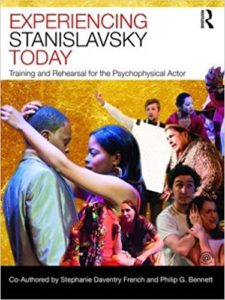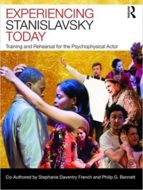Book Review: Experiencing Stanislavsky Today
 Experiencing Stanislavsky Today
Experiencing Stanislavsky Today
Stephanie Daventry French and Philip G. Bennet.
London: Routledge, 2016
ISBN 978-0415693950
In Experiencing Stanislavsky Today, authors Stephanie Daventry French and Philip G. Bennett introduce new performers to the tenets and practices of Konstantin Stanislavsky’s highly influential System of acting. The authors have coupled an expert understanding of Stanislavsky’s life and work with the latest research in psychology and physiology, providing beginning actors with a comprehensive course in Stanislavsky’s methods.
The authors indicate in the textbook’s preface that one of this book’s projects is overcoming the many misunderstandings of Stanislavsky’s System that persist in Western culture due to factors ranging from mistranslations to Soviet censorship. This effort is perhaps most clear in the re-introduction of yoga into the System, a practice that heavily influenced Stanislavsky’s work but was excised by Soviet censors from early English translations. Indeed of the four units comprising this book, the first section, “Psychophysical Conditioning” dedicates much of its content to incorporating yoga and mindfulness into actor training.
Each of the text’s four units builds on the previous sections. The first unit focuses on conditioning the mind and body for performance while introducing many of the essential elements in Stanislavsky’s System. The second and third units, comprising the bulk of the text, cover affecting others through actions and applying the System to rehearsal and performance respectively. The final unit offers an historical overview of Stanislavsky’s work and its legacy on acting. The authors do an excellent job of outlining and communicating learning objectives throughout the text. Each chapter begins with an overview section listing the elements of the System actively explored along with other relevant concepts and an outline of each chapter’s sections, topics, and exercises. Chapters conclude with a list of new theatre terms, concepts, and artists introduced in the section. Staying true to their stated goal of incorporating Stanislavsky’s work with other theatre practitioners and contemporary science, each chapter also ends by listing interdisciplinary terms, concepts and experts to research for further exploration. In addition, the chapters are filled with a wealth of exercises to use in the classroom and rehearsal.
While the comprehensiveness of the material is a great strength of Experiencing Stanislavsky Today, it is not without its drawbacks. Sometimes the authors are too exhaustive in descriptions. This risks overwhelming students with terms and concepts from a variety of acting schools and periods. And although the book is intended for new performers, the language sometimes seems to rely on a prior knowledge or at least general impressions of the Stanislavsky System. Additionally, the depth covered in this text seems ideally suited to a conservatory setting and may not translate as cleanly to a liberal arts setting. However, the textbook does come with an excellent online teacher’s guide including suggestions for adapting the work to a variety of curricula including quarterly and semester structures in a liberal arts setting.
Despite these drawbacks, Experiencing Stanislavsky Today is an excellent acting textbook for any instructor aiming to provide a thorough overview of the System. Its wealth of references to other performance practices as well as its solid foundation in the latest scientific research offers an excellent blend of traditional and contemporary acting theory and practice.
Michael Saar
Associate Professor
Lamar University

